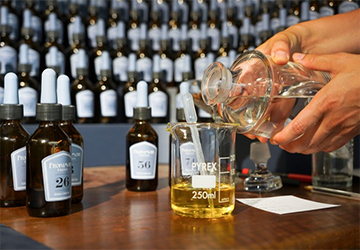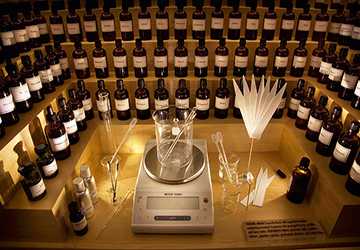Do you ever walk past someone and catch a whiff of a scent that instantly transports you to another time or place? Perfume has that magical power to evoke memories and emotions. What if I told you that you can create your own custom perfume uniquely "you"?
The task may appear daunting at first, but fear not, for in this comprehensive guide, we will lead you through each stage of the process clearly and concisely. So, roll up your sleeves, grab your favorite scents, and get started on this fragrant adventure!
Step 1: Gather Your Supplies
First things first, you'll need to gather some essential supplies. Don't worry; you won't need a laboratory for this. Here's what you'll need:
Base Oil: This is the primary carrier for your perfume. You can use jojoba oil, almond oil, or fractionated coconut oil. These are readily available at health stores or online.
Essential Oils: These are the heart and soul of your perfume. They come in a wide variety of scents. Some popular choices include lavender, rose, vanilla, citrus, and sandalwood. Choose fragrances that resonate with you.
Perfume Bottles: You'll need a container to store your custom perfume. You can repurpose an old perfume bottle or buy a new one. Make sure it's clean and sterile.
Pipettes: These are handy for precise measurements when dealing with essential oils.
Funnel: To make it easier to pour your ingredients into the bottle.
Label: Remember this! You'll want to know what's in your custom perfume.

Step 2: Create a Scent Profile
Before mixing, it's essential to have a clear idea of the fragrance you want to create. Consider the following:
Base Notes: These are the scents that form the foundation of your perfume and tend to last the longest. Think of them as the anchor. Typical base notes include sandalwood, patchouli, and vanilla.
Middle Notes: These scents emerge after the top notes evaporate and are often floral or fruity. They give the perfume body and character. Rose, lavender, and jasmine are classic middle notes.
Top Notes: These represent the fragrances that greet your senses upon the first application of the perfume. Typically, they are delicate and refreshing but tend to dissipate swiftly. Frequently encountered primary aromas include citrus, mint, and bergamot.
Accents: These are optional but can add a unique twist to your fragrance. Spices like cinnamon or herbs like basil can be great accents.
Now, think about the type of fragrance you want to create. Is it fresh and clean? Warm and woody? Sweet and floral? Having a scent profile in mind will help you select the suitable essential oils.
Step 3: Mixing Your Custom Perfume
It's time to get your hands (and nose) dirty! Following is the list of ingredients you will need:
· Base Notes: 20-30% of your blend
· Middle Notes: 50-80% of your blend
· Top Notes: 10-30% of your blend
· Accents: A few drops to taste
Here's a basic recipe to get you started:
1. Start with your base notes. Add the selected base note essential oils to your perfume bottle using a pipette. Remember that base notes are potent, so go easy at first.
2. Incorporate your middle notes, which should constitute the bulk of your blend. Explore various combinations to discover the ideal harmony that suits your envisioned scent.
3. Finish with the top notes. These provide the initial burst of scent. Be sparing; they are typically strong and can overwhelm your perfume if used too liberally.
4. If you want to add accents, do so now. Remember, a little goes a long way.
5. After combining your oils, cap the bottle and gently shake to mix everything.
Step 4: Let It Rest
This is the part where patience pays off. Allow your newly created perfume to rest for at least 48 hours. During this time, the scents will blend and mature. This resting period allows the fragrance to settle and mellow out.

Step 5: Test and Adjust
Following the resting phase, evaluating your unique fragrance is now the moment. Gently dab a modest quantity onto your wrist and allow it to unfold its character on your skin. It's important to note that a perfume's aroma may vary on your skin compared to when in the bottle.
Be observant of the fragrance's progression as time passes. The initial top notes dissipate swiftly, whereas the middle and base notes should gradually assume a more prominent role. If it doesn't meet your expectations, you can fine-tune it by incorporating additional essential oils to achieve the desired balance in the scent.
Step 6: Bottling Your Custom Perfume
Once you're happy with the fragrance, it's time to transfer your custom perfume into its final bottle. Use a funnel to avoid spills, and make sure the bottle is clean and dry. Remember to label your creation. Include the date, the names of the essential oils you used, and any notes about the fragrance profile.
Step 7: Storing Your Custom Perfume
Ensure the longevity of your personalized fragrance by storing it in a calm and shaded location, shielded from direct sunlight and abrupt temperature changes. Properly safeguarding your perfume will contribute to maintaining its delightful aroma.
Tips and Tricks for Custom Perfume Making
When crafting your scent, consider the following tips for the best results!
· Don't rush the process. Perfume making is an art; finding the perfect blend may take some time and experimentation.
· Keep a record of your formulations. This will make it easier to recreate a favorite scent or tweak it in the future.
Explore various combinations of essential oils to craft distinct fragrances
· suitable for multiple occasions or emotions.
· Be mindful of allergies and sensitivities. If you have sensitive skin, perform a patch test before applying your custom perfume to ensure you don't have any adverse reactions.
· Have fun with it! Perfume-making is a creative and enjoyable process. There are no strict rules, so trust your nose and intuition.
Conclusion
Creating your custom perfume is a rewarding and personal experience. It allows you to express your individuality through scent and create something genuinely yours. So, go ahead, explore the world of fragrance, and craft a perfume that captures your essence. Your unique scent awaits!














